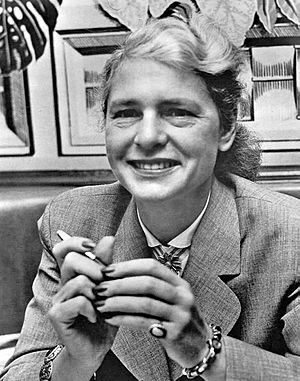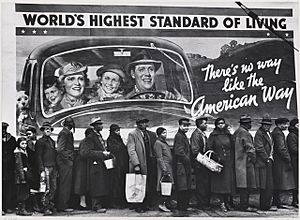Margaret Bourke-White facts for kids
Quick facts for kids
Margaret Bourke-White
|
|
|---|---|

Bourke-White in 1955
|
|
| Born |
Margaret White
June 14, 1904 New York City, U.S.
|
| Died | August 27, 1971 (aged 67) Stamford, Connecticut, U.S.
|
| Alma mater | Columbia University University of Michigan Purdue University Western Reserve University Cornell University |
| Occupation | Photographer, photojournalist |
| Spouse(s) |
Everett Chapman
(m. 1924; div. 1926) |
| Signature | |
 |
|
Margaret Bourke-White (born Margaret White; June 14, 1904 – August 27, 1971) was a famous American photographer and documentary photographer. She was known for many "firsts" in her career.
Margaret was the first foreign photographer allowed to take pictures of factories in the Soviet Union. She was also the first American female war photojournalist. One of her most famous photos, showing the building of the Fort Peck Dam, was on the very first cover of Life magazine. She passed away at age 67 from Parkinson's disease.
Contents
Early Life and Photography
Margaret White was born in the Bronx, New York. Her father was an engineer and inventor, and her mother was a resourceful homemaker. Margaret grew up near Bound Brook, New Jersey. She learned to be very precise from her father and always wanted to improve herself, like her mother.
Margaret's interest in photography started as a hobby when she was young. Her father loved cameras, which encouraged her. In 1922, she began studying animals at Columbia University. But her photography interest grew stronger after taking a class with a famous photographer named Clarence Hudson White.
She went to several different colleges, including the University of Michigan and Purdue University. She finally graduated from Cornell University in 1927. A year later, she moved to Cleveland, Ohio. There, she opened her own photography studio. She started focusing on taking pictures of buildings and industrial places.
A Career in Photography
Capturing Industry
One of Margaret Bourke-White's early clients was the Otis Steel Company. She was very good at working with people and had excellent photography skills. Her experience at Otis Steel shows how determined she was.
At first, the security people at the steel mill were hesitant to let her take photos. Steelmaking was important for defense, so they worried about national security. Also, she was a woman, and people wondered if she could handle the intense heat, danger, and dirt inside a steel mill.
When she finally got permission, she faced technical problems. Old black-and-white film wasn't good at capturing the bright reds and oranges of hot steel. The photos kept coming out completely black. Margaret solved this by using new magnesium flares, which produced bright white light. Her assistants held these flares to light up the scenes. Her amazing photos of steel factories brought her national attention.
Becoming a Photojournalist
In 1929, Margaret Bourke-White started working for Fortune magazine as an editor and staff photographer. She worked there until 1935. In 1930, she became the first Western photographer allowed to enter the Soviet Union.
In 1936, Henry Luce hired her to be the first female photojournalist for Life magazine. She worked as a staff photographer for many years, covering major events around the world.
Her photographs of the Fort Peck Dam construction were featured in Life's very first issue on November 23, 1936. One of these photos even became the cover! This cover photo was so popular that it was later featured on a United States Postal Service postage stamp.
In the mid-1930s, Margaret also photographed people affected by the Dust Bowl drought. In 1937, Life magazine published her famous photo of Black flood victims standing in front of a sign. The sign showed a white family and read, "World's Highest Standard of Living." This powerful photo later inspired the artwork for a music album.
She also traveled to Europe to document how Germany, Austria, and Czechoslovakia were doing under Nazism. Margaret and her husband at the time, Erskine Caldwell, wrote a book together called You Have Seen Their Faces (1937). It was about the tough conditions in the Southern United States during the Great Depression.
Photography in the Soviet Union
Margaret Bourke-White was the first professional photographer from a Western country allowed into the Soviet Union. She visited in the summers of 1930, 1931, and 1932 to photograph the country's first Five-Year Plan. While there, she photographed important people like Joseph Stalin and other famous figures.
She found that working in the Soviet Union required a lot of patience. She had mixed but generally positive feelings about her experiences there. Her photos were first published in Fortune magazine in 1931 and then in a book called Eyes on Russia. These photos were also used in The New York Times and in exhibitions around the world.
Bourke-White returned to the Soviet Union in 1941 during World War II. She brought a lot of equipment, including five cameras and 3,000 flashbulbs! Her work from this trip was published in a book called Shooting the Russian War in 1942.
World War II Correspondent
Margaret Bourke-White was the first female war correspondent. She was also the first woman allowed to work in combat zones during World War II. In 1941, she was in the Soviet Union when Germany attacked. She was the only foreign photographer in Moscow at the time. She took shelter in the U.S. Embassy and captured photos of the fires that followed the invasion.
As the war continued, she worked with the United States Army Air Forces in North Africa and later with the U.S. Army in Italy and Germany. She often found herself in dangerous areas where there was fierce fighting. She even flew on a combat bombing mission in 1943, becoming the first female photographer to do so.
People at Life magazine called her "Maggie the Indestructible." This was because she had survived being torpedoed in the Mediterranean Sea, attacked by enemy planes, stranded on an Arctic island, and bombed in Moscow.
In the spring of 1945, she traveled through Germany with General George S. Patton. She arrived at Buchenwald, a terrible concentration camp. She later said that using her camera was "almost a relief" because it put a small barrier between her and the horrors she saw. After the war, she wrote a book called Dear Fatherland, Rest Quietly to help her deal with the brutality she had witnessed.
Korean War
Margaret Bourke-White also worked as a photographer for Life magazine during the Korean War from 1950 to 1953.
Later Years and Legacy
In 1953, Margaret Bourke-White began to show symptoms of Parkinson's disease, a condition that affects movement. She had to slow down her career as the disease progressed. She had several operations in the late 1950s and early 1960s to help with her tremors, but it affected her speech.
In 1963, Bourke-White wrote her autobiography, Portrait of Myself, which became a bestseller. However, she became increasingly unwell and stayed mostly at her home in Darien, Connecticut.
Margaret Bourke-White passed away on August 27, 1971, in Stamford, Connecticut, at the age of 67, due to Parkinson's disease.
Her photographs are displayed in many famous museums, including the Brooklyn Museum and the Museum of Modern Art in New York. Many of her writings, photos, and negatives are kept at Syracuse University.
Exhibitions and Recognition
Margaret Bourke-White's work has been shown in many art exhibitions. She had solo shows at places like the Rockefeller Center in New York and the Art Institute of Chicago.
She received several awards for her work, including honorary doctorates from Rutgers University and the University of Michigan. In 1990, she was honored by being inducted into the National Women's Hall of Fame. In 2016, she was also inducted into the International Photography Hall of Fame and Museum.
Portrayals in Media
Margaret Bourke-White's life and work have been featured in movies and TV shows:
- Candice Bergen played her in the 1982 film Gandhi.
- Farrah Fawcett played her in the 1989 TV movie, Double Exposure: The Story of Margaret Bourke-White.
- A character based on her was played by Megan Fox in the 2019 South Korean war film The Battle of Jangsari.
Images for kids
See also
 In Spanish: Margaret Bourke-White para niños
In Spanish: Margaret Bourke-White para niños


